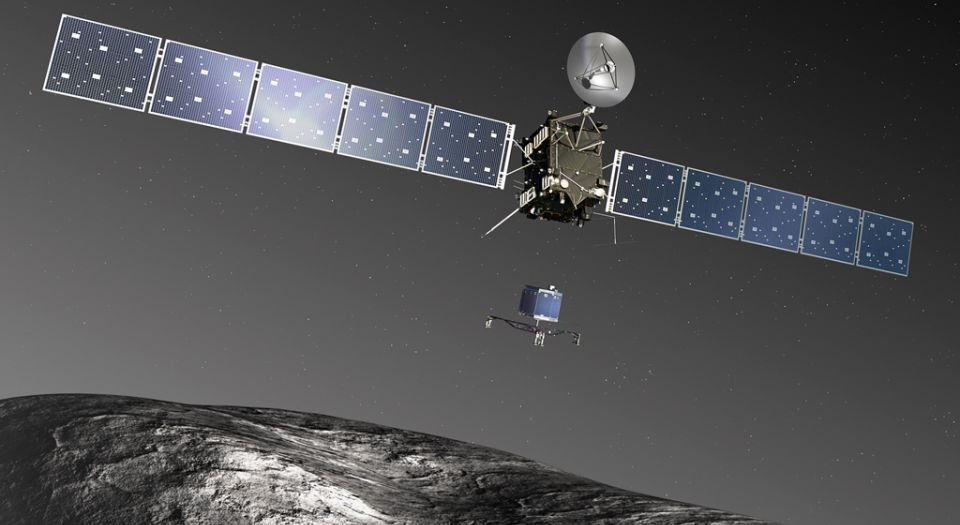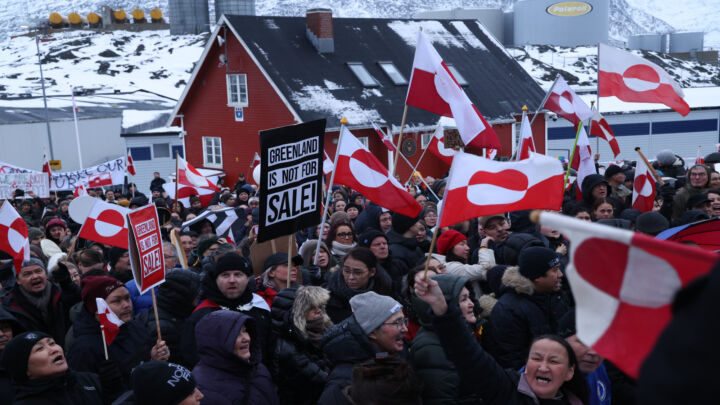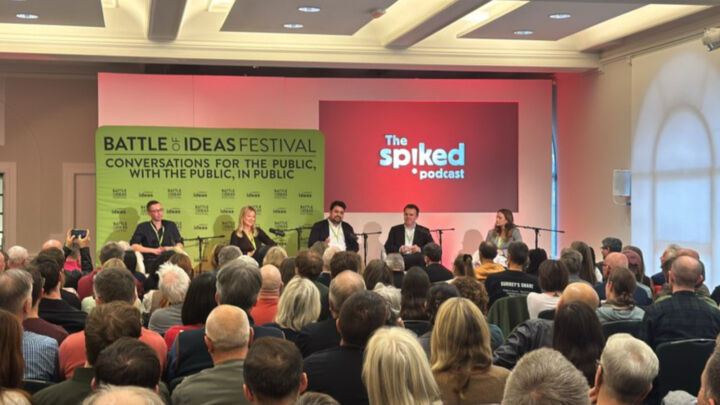10 kickass things humanity did in 2014
Even in this era of low expectations, intellectual daring finds a way.

Want unlimited, ad-free access? Become a spiked supporter.
It’s all the rage to be down about humanity. Public figures are forever lecturing us about our ‘eco-footprint’ and how our industrial arrogance turned what was an innocent ball of biodiversity spinning through space into a smoggy, nearly dead planet. Campaigners constantly tell us that if ebola doesn’t kill us, then AIDS probably will, or maybe it will be climate change, or perhaps it will be all that junk grub and booze and fags we stupidly consume. If a Martian visited Earth (more on Martians in a minute) and turned on the TV or opened a newspaper, he or she or it could be forgiven for thinking that human beings are little more than destroyers — of both the planet and themselves — who never do anything nice or brilliant.
But we do. Still. Even in this era of low expectations. Even when every cultural signal says, ‘Don’t explore’, ‘Don’t expand’, ‘Don’t go forth and multiply’. Even in the twenty-first century’s sludge of misanthropic thinking, the green shoots of intellectual daring find a way, and peek through. So here are 10 kickass things done by humanity in 2014.
10) We emailed a spanner into space
Yes, you read that right: human beings emailed a spanner into space. It seems like only yesterday — well, 20 years ago — that we were marvelling at the fact that we could send letters, and then photos, from our computers, across continents, in the blink of an eye, without having to wait for airplanes to deliver them. Now, NASA has emailed an actual object. How? Well, the International Space Station has a 3D printer; one of the ISS guys told NASA he needed a new socket wrench, and instead of making him wait months for it to be delivered from Earth, NASA emailed him instructions to put into the 3D printer and, lo, the exact spanner he needed came out. You know what this means? We finally have something very like teleportation, the dream of Star Trek and countless other sci-fi fantasies. The possibilities are endless. There is already talk of, at some future point, putting 3D printers on the moon that will dig into the moon’s crust and use its raw materials to print out the beginnings of human habitats. Would save us having to do the hard graft.
9) We made sperm
Yes, I know, the male section of humankind is always making sperm — but this year we made it without the benefit of sex, or our right hands, in a laboratory. Researchers at Cambridge University converted adult skin tissue into the precursors of sperm, and eggs, and are now exploring whether these precursor cells can become actual sperm and eggs. It’s like a winding back of time, a teasing out of the long-gone, most embryonic conditions of our cells, of ourselves. This research could have two potential impacts, one amazing, one almost unbelievable. The amazing one is that even the infertile might be able to breed children of an exact genetic match, their own children, through the creation of sperm and eggs from their skin cells. The almost unbelievable one is that this could represent the beginnings of mankind assuming mastery over evolution itself, no longer having to heed nature’s diktats about when the animal body may and may not multiply. Some will darkly shout ‘Brave New World!’ — I say so long as it’s all about choice, autonomy and giving people what they want, bring it on.
8) We found loads of new fossil fuels
You know all that talk of peak oil, peak gas, peak this, peak that? Turns out it was nonsense. Such nonsense that this year the oil price fell dramatically, for many varied reasons, but one of which is that there’s more oil than we thought. Some are going so far as to call ours an ‘age of abundance’. As the Financial Times said in November, ‘Ideas about peak oil seem to have been decisively refuted’. There is now thought to be 3.3 trillion barrels of oil and 22,900 trillion cubic feet of natural gas. And 1,040 billion tonnes of coal. Which is a lot. Three per cent more coal than we thought we had in 2011, in fact. Because that’s the thing: new fossil fuels are being discovered all the time. It’s no accident that all that peak bollocks was refuted this year: it’s a result, in large part, of the ‘shale revolution’, of what the FT calls ‘advances in the techniques of horizontal drilling and hydraulic fracturing’ — that is, of human endeavour. We might live in what feels like post-Enlightenment times, but we’re still doing that Enlightenment thing of ‘wresting nature’s secrets from her grasp’ (Francis Bacon). Up next: a uranium revolution?
7) We made more ‘ninja particles’
Yes, ‘ninja particles’ are as cool as they sound. As part of the explosion of research into nanomedicine — the implanting of infinitesimal machines or microbes into the body to attack disease — researchers have developed synthetic molecules that mimic our immune systems. It’s hoped these manmade molecules will one day, soon, be sent into the human body to attach themselves to certain microbes and cause those microbes to rupture — ‘as if they’d been hit by an explosive shuriken (ninja star)’, as one report in September gloriously said. These manmade ninjas could prove brilliantly deadly against antibiotic-resistant bugs and in bodies whose immune systems are rejecting newly transplanted organs. What was a Hollywood fantasy in the Eighties — Dennis Quaid being shrunk and sent into a human body in Inner Space — is now becoming a kind-of reality.
6) We found a former lake on Mars
From inner space to outer space, where in 2014 we discovered that a massive crater on Mars used to be a lake. Plucky, roving Curiosity, the wonderfully named, car-sized robot that NASA sent on a 350,000,000-mile journey to Mars in 2011, has been poking around and collecting data for boffins to analyse. And its examination of the sediment build-up in a 96-mile crater suggests this crater once held water, billions of years ago. Which means it could very well have generated life, too, even if just microbial life — Martian microbial life. Right now, as you chill in the holiday season, Curiosity is roaming the red planet, exploring a whole new mysterious world on humankind’s behalf. Next step: actual humans going where so far only a little robot has boldly gone, surely.
5) We made a lame man walk
‘And the lame shall walk’, said Christ in Matthew 11:5, boasting of his miraculous powers. We actually had to wait near-on 2,000 years for a man to make a lame man walk, and it wasn’t a Messiah who did it — it was cell-manipulating researchers. In 2010, a 40-year-old Pole was paralysed after being stabbed in the back. This year, thanks to scientists in London and surgeons in Poland, he can move his legs again and walk with the aid of a frame. The scientists took cells from his nasal cavity, which are among the most self-renewing cells in the human body, and nurtured and nourished them outside of his body before transplanting them into his spinal cord, injecting an invisible-to-the-naked-eye gaggle of cells into his spine 100 times over six months. And then — he moved his legs. It’s early days, but just imagine the possibilities if lifeless parts of the human body could be resurrected with injections.
4) We meddled with crops to make them more nutritious
To the fury of well-off, eco Westerners who never have to worry about where their next meal is coming from, mankind has been genetically modifying crops for years. This year we harvested crops genetically modified for nutritional value. Through splicing genes and patching organic data together in whole new ways — yes, yes, through ‘playing God’ — British scientists boosted a crop of camelina with Omega-3. The possibilities of these man-meddled nutrient-rich crops are endless, potentially delivering much-needed vitamins and sustenance to even the poorest of the world. One of the scientists described the research centre at which this work is done, in Hertfordshire, England, as ‘looking like Guantanamo’, all high fences, CCTV and Alsatians — a reminder that here in the West there are still many misanthropes ready and willing to destroy the fruits of mankind’s nature-defying labour.
3) We continued to wage war on poverty
When it was revealed in December that 92million Chinese people still live in poverty, Western media outlets had a field day. They overlooked the fact that, over the past 30 years, 753million Chinese have been lifted out of extreme poverty. Around the world, poverty is still a massive problem, but grinding poverty is in decline. In India, 126million have been lifted out of extreme poverty; in Indonesia, 66million. In 1990, 23.6 per cent of people in the developing world were undernourished; today, 11.8 per cent are — too many, but less. Two hundred years ago, the prototype modern miserabilist Thomas Malthus, hero to many greens, said there wasn’t enough stuff to sustain the people of Earth. There were 980million people on Earth back then. In the past 30 years more than 980million people have been lifted out of extreme poverty. Malthusians: getting shit wrong since 1798.
2) We continued to wage war on disease
Disease, nature’s violent whim, is in retreat from man’s deployment of science and technology. In December, the Lancet revealed that the global years lost as a result of killer diseases — from cancer to malaria to HIV — has been in steady and stunning decline since 1990. The list of once deadly diseases now cured by mankind, in the West at least, continues to grow: alongside tetanus, rabies, polio, yellow fever, measles and smallpox — causer of plagues of old — we may soon be able to add AIDS: manmade drugs now largely prevent HIV from becoming AIDS, meaning that this year deaths from AIDS were at their lowest since the peak of 10 years ago.
1) We landed a spacecraft on a comet
Six weeks after it happened, this still boggles the mind. A spacecraft called Rosetta, launched into the vast void 10 years ago, set its lander down on a comet that is only 2.5 miles wide and is travelling at 24,600 miles per hour 300million miles away from Earth. As researchers at the European Space Agency that launched Rosetta said, this is like a fly landing on a speeding bullet. Why did we do this? Well, why not? And also because exploring the comet’s make-up will boost our understanding of our solar system. The comet’s composition reflects the pre-solar system stuff from which our Sun and planets were formed. Basically, we’re going back in time, exploring with machines the original raw materials of our corner of the universe. And yet, what was the big media talking point about Rosetta? That scientist guy’s shirt, which some silly media feminists found offensive: a brutal reminder of the medievalism and miserabilism that lurk in our midst even as we do spectacular things.
All this stuff — the emailing of spanners, the deployment of miniature ‘ninjas’, the robotic exploration of space — has been achieved in an era hostile to risk-taking and suspicious of mankind, in which we’re encouraged to worship at the altar of precaution and be always safe rather than sorry. So just imagine what we might achieve if we stripped way this straitjacket of anti-human thought and truly unleashed the human instinct to explore and to know. That’s what spiked will continue to devote itself to in 2015 — battling against the backward idea that humanity is a destructive force, and reviving the view of humans as controllers of the Earth, defiers of nature, and potential masters of the universe.
Brendan O’Neill is editor of spiked.
£1 a month for 3 months
You’ve hit your monthly free article limit.
Support spiked and get unlimited access.
Support spiked – £1 a month for 3 months
spiked is funded by readers like you. Only 0.1% of regular readers currently support us. If just 1% did, we could grow our team and step up the fight for free speech and democracy.
Become a spiked supporter and enjoy unlimited, ad-free access, bonus content and exclusive events – while helping to keep independent journalism alive.
———————————————————————————————————————————–
Exclusive January offer: join today for £1 a month for 3 months. Then £5 a month, cancel anytime.
———————————————————————————————————————————–
Monthly support makes the biggest difference. Thank you.










Comments
Want to join the conversation?
Only spiked supporters and patrons, who donate regularly to us, can comment on our articles.